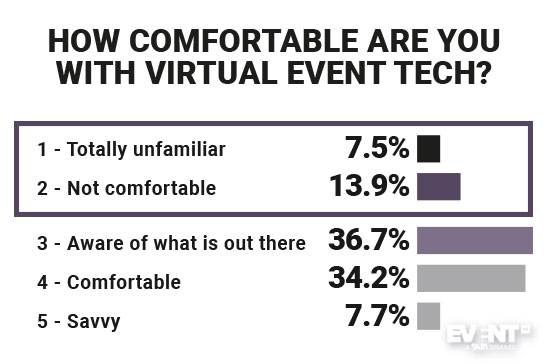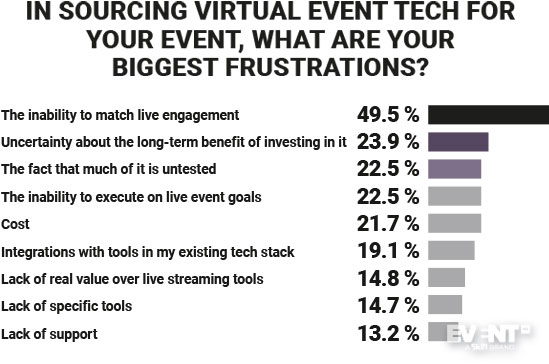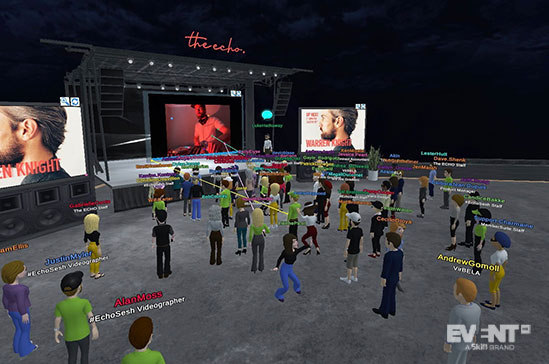Virtual has been a lifeline for the events industry throughout the pandemic, but with so many (mostly free) events and content now accessible to anyone, anywhere, the market has very little barrier to entry.
At first, people were taken in by the novelty of these new online alternatives, but they are increasingly experiencing Zoom fatigue. Planners are finding it hard to sell more of the same types of events. The pressure to create not only exceptional content but unique and engaging experiences that differentiate one event from the rest is at an all-time high.
The key to designing more marketable events that will drive attendance, provide more opportunities for higher-touch brand engagement for your sponsors, and ultimately increase profit is a platform that gives you the tools for engagement, networking, connections to brand stakeholders, and monetization.
In this post, we’ll discuss the importance of combating Zoom fatigue and how virtual event tech can help planners market their events and generate a sustainable revenue stream from online events.
The Importance of Investing in Virtual
Although much of the industry has made the transition online, there are still planners who may be wary of investing in dedicated virtual event platforms for various reasons. However, it’s important to recognize the opportunity cost of not doing so and to address the obstacles standing in the way in order to secure a sustainable revenue stream moving forward.
OBSTACLES TO INVESTMENT IN VIRTUAL
Lack of familiarity and knowledge. For planners who are unfamiliar with the event tech landscape — over 20 percent consider themselves totally unfamiliar or not conformable with virtual event tech — it can be overwhelming to figure out what’s available and how to go about sourcing a dedicated tool for virtual events. Those who treat virtual events simply as glorified webinars won’t see much of a reason to look beyond platforms like Zoom and WebEx, which can be used for free.


Lack of confidence. These issues are compounded by the fact that these webinar services have been around for years, and although they weren’t built for it and don’t provide compelling virtual event experiences, they have strong brand recognition and a large user base. Many event organizers simply don’t have the same confidence in new platforms.
In fact, a recent EventMB survey found that 23 percent of planners consider the fact that many tools are untested their biggest frustration when sourcing virtual event tech.


Lack of appropriate solutions. Another major roadblock when it comes to getting onboard with virtual tech is the lack of necessary features in many platforms, particularly for trade shows. The imperative is therefore both on planners to find solutions and on tech providers to educate about their offerings and develop what planners need to be able to design marketable and monetizable events.
IMPACT OF ZOOM FATIGUE ON EVENT PERFORMANCE
Failure to offer compelling event experiences in the virtual space will inevitably take a toll on event performance and revenue goals. Just as planners now have fewer barriers to entry when setting up a webinar on Zoom, attendees are no longer faced with the cost and time commitment of travelling to a live event.
Attendees now have more content than ever accessible to them, and much of it is available for free and on-demand. This has negatively impacted events as competition has increased while FOMO, which has been the cornerstone of event marketing in the age of social media and event experiences, has declined.
In general, people are less willing to pay for online experiences, especially if they don’t believe they’ll get much value from them and if there are several free alternatives. According to Chris Gerhart, President of Crescent Event Productions, justifying ticket price comes down to providing the same value you would with a live event:
“Know that the value that you’re delivering with the live event is the content and the community engagement…if you can create content and community in a frictionless way for the attendees, that generates greater ROI for your sponsors, then there’s no reason to devalue your offering.”
As it stands, few events stand out, and somewhat predictably, few are turning a profit. Most event organizers (71 percent) have not been able to recoup more than 25 percent of their revenue through virtual.
VIRTUAL IS MORE THAN A STOPGAP
When the pandemic first hit, event organizers scrambled to recoup losses in whatever way possible, which in some cases meant pivoting to a virtual format. However, virtual was largely meant to be a temporary solution to staunch the bleeding until “real” events could resume.
In fact, 24 percent of planners cited being uncertain about the long-term benefit of investing in virtual tech as their biggest frustration in sourcing it.
But virtual events have been a long time coming; we’ve been writing about them for years. The coronavirus has just been a catalyst for introducing them on a wider scale and learning about their broader benefits.
And as a return to normalcy seems more and more far off, it’s important for planners to shift their mindset and adopt a virtual-first approach. This isn’t simply about moving what happens at a live event over to virtual, but treating virtual events as full productions that require the right partners, and that people should be willing to pay to attend. Think about it: you would never be able to put together an impressive physical event for free (or almost free), so that shouldn’t be the mindset for virtual.
For online events, a key partner is a virtual event platform that can help create a better overall experience for stakeholders and help troubleshoot should anything go wrong. The Echo from Event Farm, for example, offers various features to elevate virtual events to robust digital experiences, based around 3D meeting environments and virtual avatars that immerse attendees in the event.
Elevated Event Experiences are Easier to Market
Standout virtual events are all about high production value and features that offer attendees the ability to meaningfully connect with each other and with brands of interest. This is where webinars often fall short, making them difficult to market profitably, and where a dedicated event tech partner can help you take your event beyond just another conference call.
Audience Interactivity
Key engagement features like chat and polls are possible on Zoom, but virtual event platforms bring real-time engagement and in-person interactions back to the event experience. For example, Event Farm’s virtual events solution, The Echo, uses 3D spacial voice and audio for attendees to network on-site, which allows for the tens of thousands of simultaneous conversations to happen as it might at an in-person event.
Session Formats
What else can’t Zoom do? Varied session formats. Mixing up presentations, breakouts, and other session types is an effective way to keep people interested despite lowered online attention spans.
For example, Event Farm’s virtual solution, The Echo, supports live-streamed keynotes, roundtable discussions, one-on-one meetings, and more to allow attendees to interact in different ways and which all come with corresponding 3D environments. Networking sessions can take place in virtual lounges, and plenary sessions can be set against the backdrop of an auditorium.
High-end Production Support
3D environments and other production value-adds are essential for differentiating your event from the talking heads in Zoom. Virtual venues are popping up to help you with that.
Event Farm combines a virtual venue with event engagement technology to facilitate networking, attendee engagement, and audience interaction. They also offer comprehensive support, which can be a huge help if you’re swapping in speakers, MCs, and other moderators.
Unique Activities
Finally, including activities or workshops that you wouldn’t be able to do at a live event can further set your event apart and help promote the advantages of virtual. One example could be to organize virtual concerts or timed scavenger hunt tournaments with team members from around the world.


Courtesy of Event Farm
Sponsored Connections Should Attract Attendees
The above strategies will differentiate your event, help you convey value to attendees and sponsors, and ultimately help reach your event attendance goals. However, it’s important to keep in mind that paid events aren’t everything — revenue can also come from sponsorships, subscriptions, etc.
The right event tech will help you create those opportunities in a way prospective attendees will find appealing.
During our most recent virtual event, the Future of the Event Industry, William Thomson, MD of Gallus Events, emphasized that delivering value through a virtual event isn’t necessarily achieved in the same way as for a live event and may entail completely rethinking certain parts of the experience.
With this in mind, think about the value sponsors can provide to attendees in different ways. Again, this isn’t about simply translating an exhibit hall online, but designing creative and effective opportunities for connections.
One option may be to offer exclusive sponsored sessions in streamed breakouts, which can also take place in special branded virtual rooms using Event Farm. Incorporating gamification is another proven strategy to engage attendees, and inviting sponsors to host games and/or giveaways can be a memorable way to foster those connections.
For example, at their recent Echo Virtual Summit, Event Farm used their tech to divide attendees into groups and prompted them to find each other on the virtual soccer field in order to network with new people. This could easily be reimagined as a sponsored activity during which attendees have to find and visit a certain number of sponsors, with those earning the most points receiving a sponsored gift.
Finding new ways for sponsors to deliver value in an online format will help you attract both sponsors and attendees, ultimately leading to more profitable events.
Virtual Platforms Provide Key Marketable Insights
Collecting and analyzing data has never been more important and — theoretically — has never been easier. A key advantage of virtual is that many tools come with built-in data collection and reporting features that can provide you with detailed information.
Engagement, event performance — these data points can help you to double down on what attendees value most in your communications.
This, in turn, leads to increasingly marketable (and profitable) events. However, many tools are still lacking this crucial feature — for example, this was a key element missing from Moz’s recent pivot to virtual and has made it difficult for them to extract meaningful insights beyond survey responses.
Be sure to choose a tool that has robust reporting capabilities so you don’t miss out on key insights that will help improve and market your event. Event Farm offers various metrics that can be tracked throughout the event to improve marketing strategy and performance.
Unique Logins by Day, for example, indicates which event days have the most logins and can be useful when targeting on-platform messaging and prompts to get people onboard. Concurrent Users by Room allows planners to determine the most popular sessions and activities to see where the best networking opportunities lay and highlight popular sessions and speakers in their marketing materials.
Another available metric is Rooms by Day, which shows how many rooms were visited during the event and can help planners provide more value to sponsors by encouraging more engagement with any under-performing sponsored rooms (such as by assigning points for visiting certain rooms).
Collecting and analyzing data may present an additional learning curve for planners who aren’t already accustomed to doing so, but virtual event tools greatly facilitate the process, and being able to take action to improve events based on concrete stats will be well worth it.
IN CONCLUSION
2020 has been an incredibly challenging year for the global events industry, but it has also been an opportunity for planners to switch up their offerings and prepare for the future. Virtual is here to stay, and it’s crucial for event organizers to embrace the format as a sustainable way to host profitable events.
Investing in tech beyond webinar solutions like Zoom is key to delivering ongoing value to stakeholders in an online (or hybrid) environment, creating more marketable events, and ensuring long-term financial viability.
For more information on how virtual event tools can help you elevate your online event experience, reach out to Event Farm to request a demo of their comprehensive platform.






